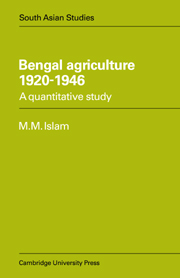Summary
The establishment of British rule in India led to a great expansion of the external demand for her agricultural raw materials. Whereas in the preceding centuries production for domestic consumption and transactions in kind had been the dominant pattern, under the changed circumstances in the nineteenth century agriculture became much more market oriented. In other words, growing emphasis began to be put on the production and marketing of certain crops which were needed for export on the world market. Working in the same direction was the influence of the growth of commercial centres and the development of certain industries. The net result was that the surplus productive capacity in agriculture, which had for so long been locked up as a result of the small size of market, now came to be increasingly utilised.
Among the regions of India where the impact of the widening of the market was felt, Bengal occupied an important position. The effect of the widening market was naturally concentrated most in the agricultural sector. In particular, foreign demand for raw jute and the development of the jute industry in and around Calcutta stimulated the production of this crop. The impetus which was thus given by the establishment of wider commercial contact with the outside world led to a remarkable expansion of agriculture but it seems that by 1920 the possibilities for the further expansion of cultivation had become limited. An important development which accompanied the process of widening of the market was the gradual increase of the pressure on land along with the growth of population.
- Type
- Chapter
- Information
- Bengal Agriculture 1920–1946A Quantitative Study, pp. 1 - 16Publisher: Cambridge University PressPrint publication year: 1979



